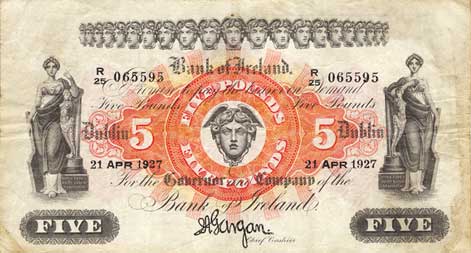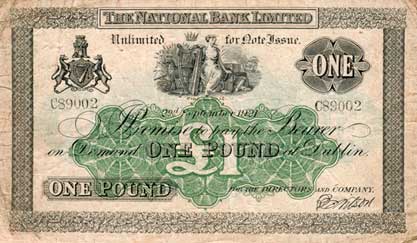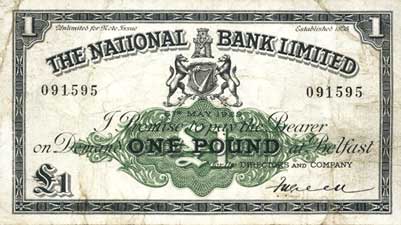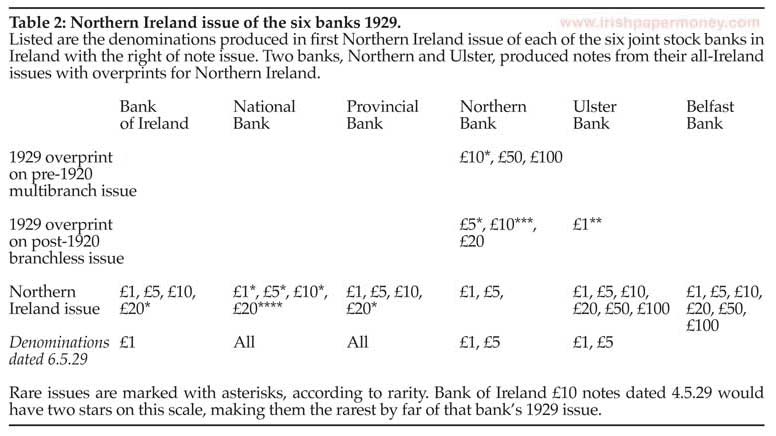
The partition of Irish currencies: from one all Ireland issue, to three separate issues
From All-Ireland issue to Northern Ireland Issue. Some banks modified their issues to a minimal degree to create their Northern Ireland issue.
The Assimilation of Currencies Act (1826) fixed the value of the Irish Pound at par with that of the English Pound. The Bankers (Ireland) Act, 1845 laid the groundwork which allowed the development of a stable system of currency circulation in Ireland based on banknotes issued by six large joint stock banks with branches throughout the country.
The partition of Ireland in 1921, the independence of the Irish Free State and creation of Northern Ireland in 1922 would lead to the end of this long stable system and to the partition of Irish currency between two jurisdictions, and into three separate banknote issues, whilst maintaining the link with the English Pound.
By 1922 the six note issuing banks had largely completed the Transition of Irish Currency to more modern banknote designs.
Ireland was ruled by the British until December 6th 1922. The political partition of the island of Ireland into the Irish Free State (composed of 26 counties) which became largely independent, and Northern Ireland (composed of 6 counties) which remained part of the United Kingdom, effective from December 6, 1922 had outwardly not affected the currency union of the island.
During British rule six of the joint stock commercial banks had the right to issue banknotes under various rules and restrictions, and provided the paper money in use throughout the country. The right of note issue continued during the early years of the Irish Free State.
Several years after the Partition of Ireland the currency circulating in Ireland changed completely with the provisions of the 1927 Currency Act in the Irish Free State. The Partition of Irish Currency resulted, with the currency circulating on the island being split between the two jurisdictions of the Irish Free State and Northern Ireland.
The Currency Commission Ireland was created to control the issue of currency in the new Irish state. In 1928 it commenced the issue of Legal Tender Notes (A Series), the first of two new banknote issues in The Irish Free State.
Eight commercial banks in the Irish Free State, the five notes-issuing banks plus the Hibernian Bank, Munster & Leinster Bank, and Royal Bank of Ireland, were admitted into the Currency Commission as the Associated Banks.
The existing note issues in the island of Ireland were replaced in the Irish Free State by Legal Tender Notes, and Consolidated Banknotes issued by the Associated Banks under the control of the Currency Commission; and a new Belfast issue by the note issuing banks in Northern Ireland, controlled by the Bank of England. The appointed changeover day for this partition of Irish currency was 6 May 1929. Thus, almost all of the existing banknote designs, many only a few years old, were again replaced by new issues. The Belfast Banking company notes were the only exception, as 100% of its post-1921 notes were apportioned to Northern Ireland.
For their first Northern Ireland issue on 6 May 1929, the National Bank produced an entirely new design. The Northern and Ulster banks used existing unissued notes with overprints initially, with Northern Bank producing a new design series shortly after. Ulster Bank and Bank of Ireland adapted their existing branchless General Issue notes by restarting serial numbers on all note issues, and Bank of Ireland making its notes payable in Belfast instead of Dublin.
The banks operating in Ireland were varied in nature. Six of the banks issued banknotes under the 1845 Act, Bank of Ireland, National Bank, Provincial Bank of Ireland, Ulster Bank, Belfast Banking Company and Northern Banking Company.
The National had its head office in London and was an English clearing bank—it was outside the jurisdiction of the Irish Free State. The Provincial was incorporated in Great Britain, with head office in Dublin.
The Bank of Ireland had been founded by Royal Charter, with head office in Dublin, and had been banker to the government. It thus always had liquidity in times of crisis and had been able to function as somewhat of a Central Bank in the past by helping other banks when appropriate.
The Ulster and Northern banks had their head offices in Belfast, Northern Ireland, which was also outside the jurisdiction of the Irish Free State.
Finally, the Belfast Banking Company had ceased operating in the Irish Free State area from 1923, and sold all its branches therein to the Royal Bank of Ireland, but its notes continued to circulate freely.
Four other joint stock banks did not issue notes. The Royal Bank of Ireland operated only within the Irish Free State and had its head office in Dublin, as did the Hibernian Bank. The Munster & Leinster Bank had its head office in Cork. The newest bank, the National Land Bank was set up in 1919 by the state, had been renamed the National City Bank before being merged into Bank of Ireland shortly before the 1927 Currency Act came into force.
The partition of the currency was precipitated by the decision of the government of the Irish Free State to take control of the currency circulating within its jurisdiction. Currency circulating consisted of paper money issued by the six Irish note issuing joint stock banks; English coinage, which was Legal Tender in England and Wales; English Treasury notes, replacing sovereigns and half sovereigns in circulation; and occasional Bank of England and Scottish notes. None of these instruments were Legal Tender in the Irish Free State.
Various factors influenced the government of the Irish Free State to move towards a currency of its own, and to reform the extant currency issue status in Ireland in 1922. Pratschke (1969) notes that the existing monopoly of currency issue by some of the banks was regarded as being unfair to the other banks. Additionally, the taxation on the extant note issues of the banks was payable exclusively to the Bank of England. One aspect of the Irish government’s approach was that of how to apply a taxation on the paper money issues within its borders. However, the imperative was to maintain overall financial stability, and to keep the population’s confidence in the new government’s ability to do this. Maintaining the link to Sterling was therefore considered to be essential.
A banking commission was convened in 1926 to decide on how to proceed with the issue of a currency for the Irish Free State. Its recommendations lead to the creation of the Currency Commission in 1927, and the partition of the Irish currency between the Irish Free State and Northern Ireland. Table 1 sets out how the effect of the partition of currencies was to replace, in 1928, the banknote issue of the six joint stock banks with three new note issues, two in the Irish Free State, and one in Northern Ireland.
The Irish Legal Tender Note issue, produced by the Currency Commission in the Irish Free State on behalf of the government, first entered circulation on 10 September 1928. The Consolidated Bank Note issue, governed by the Currency Commission, replaced the existing issues of the banks, was of a uniform design, and was shared by the eight joint stock banks operating in the Irish Free State—five of the original six note-issuing banks (excluding the Belfast Banking Company), plus the three others which had not had the right to issue banknotes under British rule, but were granted note issue rights in the Free State under the 1927 Currency Act. These notes first entered circulation on 6 May 1929. Taxation of these notes was payable solely to the Irish government.
They Currency Commission determined the proportion of Old Notes (pre-partition banknotes) issued by the banks in circulation, which appertained to Northern Ireland as follows: Bank of Ireland, 13%; Provincial Bank of Ireland, 18%; National Bank, 5%; Ulster Bank, 58%; Northern Bank, 72%; Belfast Banking Company 100%. The effect of this was to assign approximately 30% of the total value of outstanding notes of all the banks to their Northern Ireland issue (Moynihan, 1975, p. 160).
The Bankers (Northern Ireland) Act, 1928 resulted directly from the 1927 Irish Currency Act and set limits for the note issues of the commercial banks in Northern Ireland. Table 1 shows the actual amounts that this translated into for each bank. These two Acts together brought the banking system in Ireland into line with the changes in the political landscape that had occurred since 1919.
The allocations of the total numbers of notes in circulation were readjusted first between Northern Ireland and the Irish Free State, reflecting the number of branches of the banks in each jurisdiction. Those in the Irish Free State were also readjusted to allow for an allocation for the three banks which formerly did not have note issue rights. The overall amount in circulation was also increased in the Irish Free State

* The Belfast Banking Company’s Northern Ireland issue dated from 1922. The bank withdrew from operations in the Irish Free State and confined itself to Northern Ireland only.
** The Hibernian Bank and Munster & Leinster Bank only acquired the right to issue notes as part of the Consolidated Bank note issue. With no previous note issue rights, they did not have a Northern Ireland issue.
Note: Based on a Table in Pratschke, J. L., 'The Establishing of the Irish Pound: A Backward Glance', Economic and Social Review, 1, 51-76. (1969).
Several facts are evident from Table 1. Banks new to banknote issue received a quota at the expense of the Bank of Ireland and Provincial bank of Ireland note issue quotas. The overall total for all-Ireland almost doubled—this should also be considered in the context of the value of Legal Tender Notes in circulation by 31 March 1929, at slightly over £2,500,000. A large increase in total money supply was underway. Interestingly, Ulster Bank, generally considered to be a Northern Irish bank, had a much larger quota in the Irish Free State than in Northern Ireland.
All six of the Joint Stock banks that had the right of note issue under British rule in Ireland continued to issue their own notes in Northern Ireland as part of the ‘Northern Ireland Belfast Issue’ from 1929 as set out in Table 2. The Northern Ireland issue first entered circulation on 6 May 1929 in parallel with the Consolidated Bank Note issue in the Irish Free State. The banks produced their own designs for these notes, as they had done so with the all-Ireland issue. Taxation on these notes was payable solely to the British government. Many of the first banknotes of the Northern Ireland issue were dated 6.5.29, the only instance when different banks issued notes with the same dates.
Each of the banks approached the partition of currencies, and the creation of a Northern Ireland issue slightly differently. The denominations issued varied between the banks, as can be seen in Table 2. The commencement of the Northern Ireland issue resulted in many scarce issues, which include some very rare banknotes.
The first Bank of Ireland Northern Ireland issue (1929–1958) was derived from the bank's new 1922 issue by merely changing the head office of payment to Belfast in place of Dublin, and restarting the prefixes on its notes. Otherwise, the design remained entirely unchanged, and the banknotes continued to be printed at its head office in College Green in Dublin, though this detail was removed from the notes themselves. The bank printed denominations from £1 to £20, dropping the £50 and £100 notes. A small quantity of £20 notes were printed, with one date, 9 May 1929. The notes are seldom offered.
The prefixes that the bank used on its Northern Ireland issue are noteworthy, in that they could be said to follow on somewhat from its 1922–1928 all-Ireland issue. £1 notes started with prefix B/10, following on from A; £5 notes started with S/10, following on from R; £10 notes started with U/10, an anomaly, as the previous issue had also used U; £20 notes started with X/10 which could be regarded as following on from the previously used prefix, W. All of the notes used a six digit serial number with leading zeros.
The Bank of Ireland is notable in that it printed two denominations of its Northern Ireland issue with dates prior to 6.5.29: £5, 5.5.29; £10, 4.5.29. These dates pre-dated the 6.5.29 changeover appointed day, and were required to be altered. Thus, both of these printages were amended part way through with the overprinting of a 1, producing 15.5.29, and 14.5.29 respectively. A quantity of each denomination with the anomalous earlier dates entered circulation. £10 notes dated 4.5.29 are rare, with a small number produced—highest number seen U/10 011869 (Blake & Callaway, 2009). The corresponding £5 note is less rare, though still a scarce note.


Bank of Ireland £5, All-Ireland Issue above, Northern ireland issue below. Designs are almost identical
The National Bank scrapped its 1921 design and produced an entirely new design for the first National Bank Northern Ireland ‘Belfast’ issue (1929–1934). The bank produced four denominations up to £20, dropping the £50 and £100 denominations. £20 notes were produced in very small quantities with a printage of 2,500 (Blake & Callaway, 2009), and the notes are extremely rare, with only three confirmed examples known. All denominations use a five digit serial number with leading zeros, without a prefix.
Prior to partition the National Bank was one of the larger banks in Ireland. However partition resulted in most of its branches being located in the Irish Free State, with only five being located in Northern Ireland. Thus, the National Bank’s notes of its Northern Ireland issue are the scarcest of the five Northern Ireland banknote issues, see Table 2. Conversely, the National Bank is one of the most common banks of the Consolidated Bank Note issue.


National Bank £1, All-Ireland Issue above, Northern ireland issue below, a completely new design
The Ulster Bank First Northern Ireland issue (1929–1934) was identical to the 1926 issue except that it bore the text ‘NORTHERN IRELAND ISSUE’ on the top of each note.
The Ulster Bank 1929 Overprint, Series D First Northern Ireland Issue, took the form of two variations of an overprint on unissued £1 notes of the 1926 variant of its final all-Ireland issue Series C Type B, Ulster Bank Belfast, those payable in ‘BELFAST’ only: one variation of overprint on numbered, dated notes; the other on blank unnumbered notes.
In the first instance a large overprint was applied in the centre and each side on small groups of notes by means of a stamp with the text ‘ISSUED IN NORTHERN IRELAND AFTER 6TH MAY 1929’. Three of the five dates of this issue have been seen with the overprint: 1 Mar 1926, 1 Jun 1927, 1 Dec 1927. The remaining two dates may also have been overprinted. These overprinted notes are rare. There remains much more research to be done on these to determine their exact nature, and the proportions of notes that were overprinted.
In the second instance, when the actual Northern Ireland Issue was produced it started with an overprint on unnumbered blank notes of the earlier 1926 issue. The first two dates, 6 May 1929 and 1 Jun 1929 have ‘NORTHERN IRELAND ISSUE’ overprinted on the top of the notes.
Subsequent dates, including some dated 1 Jun 1929 have the text engraved on the plate. Serial numbers for these notes were restarted at 1 without leading zeros. It is likely that the overprints were both a means to use up a supply of existing notes, and possibly to give the bank time to produce a new dedicated Northern Ireland issue by altering its printing plates.
Ulster Bank’s dedicated Northern Ireland Issue was very similar to its 1921 post-multibranch issue, with serial numbers restarted at 1, and minor alterations to the notes. The bank issued the full range of denominations up to £100. The first £5 note date was 6.5.29, with the first issue of all the higher denominations all being dated 1 June 1929.
The Northern Bank made extensive use of overprints on stocks of its existing notes, which suggests that it had relatively large stocks on hand by 1928. Interestingly, the Northern overprinted two previous Types of notes, the older multibranch series, and the post-1920 series with branches discontinued. Some of these notes were still being issued in the 1960s.
There are two variations of the overprint on the Northern Bank 1929 Northern Ireland Overprints, Series E. ‘NORTHERN BANK LTD, BELFAST’ was overprinted on small size £5 notes dated 1 Sep 1927 (Northern Banking Company 1921-1927 Series D Type B), and on large size multibranch £10 notes dated 1 Mar 1920 (Northern Banking Company 1918-1920 Series C Type E). ‘NORTHERN BANK LIMITED, BELFAST’ was overprinted on large size £10 notes dated 10 Oct 1921 and £20 notes dated 20 Oct 1921, and on multibranch £50 notes dated 25 Apr 1918 and £100 notes dated 2 Jun 1919. In no instance was there any amendment of the dates on the banknotes, and 1929 does not appear on any of them.
Additionally, the Northern Bank changed its name from ‘Northern Banking Company Limited’ to 'Northern Bank Limited’ in 1929. This was reflected in the overprint on the earlier notes, which carried a discrete ‘Formerly’ above the old bank title. The £5 note and both £10 note types are quite rare, with the higher denomination notes being quite easy to obtain.
The Northern Bank also issued £1 notes and £5 dated 6.5.29 which were a modification of the bank’s 1921 all-Ireland issue. Prefixes on these notes were restarted as N-I/A on both denominations, with six digit serial numbers on £1 notes and five digit serial numbers on the £5 notes. £10 notes of the new design were issued in 1930, with £50 and £100 notes following in 1943—it can be inferred from the relative lateness of production of the new designs of these higher denominations that there were relatively large stocks of the overprinted notes available, and little demand for them.
The Provincial Bank of Ireland took the opportunity to produce a new design for its first Northern Ireland issue (1929–1944). Large size banknote designs and £50 and £100 note denominations were discontinued, in favour of smaller modern notes, printed on both sides, and similar in design to the 1920 issue. Four denominations were produced: £1, £5, £10, £20. The first issue were all dated 6.5.29, and were all the same size.
All denominations bore the prefix N with a serial numbers of six digits on £1 and £5 notes, five digits on £10 notes, and four digits on £20 notes, all with leading zeros. With large quantities in production, £1 notes progressed on to prefixes of N/A, N/B etc. The numbers of notes per prefix and date varied for the £1, but never exceeded 200,000 per prefix.
Provincial Bank notes dated 6.5.29 are quite scarce for all the denominations, with the £20 note being rarely offered.
The Belfast Banking Company had effectively produced its first Northern Ireland issue in 1922, when it withdrew from operations in the Irish Free State.
In 1929 its entire note issue was apportioned to Northern Ireland as all its branches were located there. Thus, it was unaffected by the changes which caused the other banks to revise their note issues at that time.
The bank issued notes in denominations of £1 up to £100. Prefixes of a single letter, or a letter over a letter were used in combination with serial numbers of four digits, all starting with 1. The 1922 issue continued unchanged up to 1968. The bank was then merged into the Northern Bank.

Original Version (2017)
Original [print] version (2017), published in Coin News as: 'The Partition of Irish Currencies, Irish banknotes 1928–1930', July 2017, p85.
References
1. Annual Reports of The Currency Commission and The Central Bank of Ireland (1927–2001). Irish Government Publications.
2. Bank of Ireland Archives, Dublin.
3. Blake, R., Callaway, J. (2009). Paper Money of Ireland, 1st Ed.
5. Central Bank of Ireland Archives, Dublin.
6. Mac Devitt, M. (2005). Irish Banknotes. Irish Paper Money 1783–2001, 3rd Ed.
7. Mac Devitt, M. “The ‘Lady Lavery’ Legal Tender Note Issue of the Irish Free State, 1928” Coin News, December 2015, p76.
8. Mac Devitt, M. “The ‘Ploughman’ Consolidated Bank Note Issue of the Irish Free State, 1929–41” Coin News, August 2015, p77.
9. Moynihan, M. Currency and Central Banking in Ireland 1922–60, Gill & MacMillan in association with the Central Bank of Ireland., 1975.
10. Pratschke, J. L. “The Establishing of the Irish Pound: A Backward Glance”, Economic and Social Review, 1, 51-76. (1969).
11. The Bankers (Northern Ireland) Act, 1928, Last accessed 19.09.2021.
12. The Banknotes (Ireland) Act, 1920, Last accessed 19.09.2021.
13. The Bankers (Ireland) Act, 1845, Last accessed 19.09.2021.
14. Royal Bank of Scotland Archives, Edinburgh.
The Transition of Irish Currency, Irish banknotes 1918–1928
The Partition of Irish Currency, Irish banknotes 1928–1930
Irish Three Pound Notes
Banknote Design Evolution 1824 to 1916
Contemporary Forgeries of Early Irish Banknotes, ca1800-1930
Limerick Soviet Notes
Irish World War 2 Banknote Issues
Low Number Irish Banknotes
Irish Joint Stock Banks of Note Issue from 1783
Irish Legal Tender Note Specimens
Ploughman Scan Survey (PSS)
1 Pound Ploughman
5 Pounds Ploughman
10 Pounds Ploughman
20 Pounds Ploughman
50 Pounds Ploughman
100 Pounds Ploughman
Irish Ten Shilling Notes
1 Pound Note Lady Lavery
5 Pounds Lady Lavery
10 Pounds Lady Lavery
20 Pounds Lady Lavery
50 Pounds Lady Lavery
100 Pounds Lady Lavery
1 Pound Note, Queen Medb
5 Pound Note, John Scotus Eriugena
10 Pound Note, Jonathan Swift
20 Pound Note, W. B. Yeats
50 Pound Note, Turlough O'Carolan
100 Pound Note, Grace O'Malley
5 Pound Note, Sister Catherine McAuley
10 Pound Note, James Joyce
20 Pound Note, Daniel O'Connell
50 Pound Note, Douglas Hyde
100 Pound Note, Charles Stewart Parnell
Northen Ireland Polymer notes
Bank of Ireland Polymer Notes
Danske Bank Polymer Notes
Ulster Bank Polymer Notes
![]()